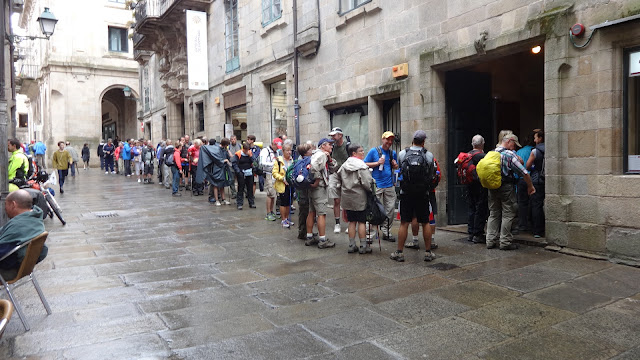Completo?
Today marked the official end of our pilgrimage - the quest to walk to the Cathedral at Santiago de Compostela - to reverence the bones of Saint James. In the cathedral in a niche behind metal bars lies the container of those bones. You cannot touch the container - you cannot see the bones - in faith you know they are there. In reverence we stand - bow our heads - in thanksgiving we offer our prayers for a safe - pilgrimage. We allow tears to well up in our eyes as we consider what we have done. By ourselves - no tour guide - no bus - our planning - research - our faith has brought us to this moment. In this Holy Week - our eyes fill with tears - as we thank our God for all our years of life - for all the Lents we have walked - for all the blessing He has given us.
In a Niche
Behind protective bars
Remains of Saint James
Well deserved smiles
Pilgrim Mass
The silver botafumerio hanging top center
The Botafumeiro is suspended from a pulley mechanism in the dome on the roof of the church. The current pulley mechanism was installed in 1604. The present Botafumeiro is made of an alloy of brass and bronze and is plated by a very thin 20 micrometer layer of silver. The current one was made in 1851. The Santiago de Compostela Botafumeiro is one of the largest censers in the world - weighing 176 pounds and measuring 5 feet in height. It is normally on display in the library of the cathedral - for certain important religious occasions, it is brought to the floor of the cathedral and attached to a rope hung from the pulley mechanism. It is swung normally once a week during the pilgrim Mass. For special groups it can be used for a 450€ fee. On a future post I will show this being used at the end of Mass.
Today even more pilgrims than yesterday waiting for their compostela
Our Compostelas
Arlene's Compostela
Deacon Dale's Compostela
Pilgrim Passports showing the stamps each of us collected
Pilgrim Passports - we collected one stamp for each albergue we stayed at. From Sarria we had to collect two stamps each day - one at our albergue and one at a church or restaurant we visited during the last 100 kilometers as proof that we were actually walking. Those who were biking had to collect stamps from the last 200 kilometers. Some people were so desperate to collect the stamps that they cheated by driving and not walking or cycling. Walking the Camino for residents of Spain is very important for their resumes when applying for some jobs and promotions. For those who honestly prepare themselves for Easter - no proof required - God knows their hearts - what was done.
Deacon Dale











